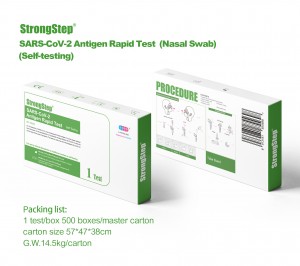Novel Coronavirus (SARS-CoV-2) Multiplex Real-Time PCR Kit
This highly sensitive, ready-to-use PCR kit is available in lyophilized format (freeze-drying process) for long-term storage. The kit can be transported and stored at room temperature and is stable for one year. Each tube of premix contains all of the reagents needed for the PCR amplification, including Reverse-transcriptase, Taq polymerase, primers, probes, and dNTPs substrates. It only need add 13ul distilled water and 5ul extracted RNA template , then it can be run and amplified on the PCR instruments.
The qPCR machine should meet the following requirements:
1. Fit 8 strip PCR tube volume 0.2 ml
2. Have More than four detection channels:
|
Channel |
Excitation (nm) |
Emission (nm) |
Pre-Calibrated Dyes |
|
1. |
470 |
525 |
FAM, SYBR Green I |
|
2 |
523 |
564 |
VIC, HEX, TET, JOE |
|
3. |
571 |
621 |
ROX, TEXAS-RED |
|
4 |
630 |
670 |
CY5 |
PCR-platforms:
7500Real-Time PCR System, Biorad CF96, iCycler iQ™ Real-Time PCR Detection System, Stratagene Mx3000P, Mx3005P
The difficulty of cold chain transportation of Novel Coronavirus nucleic acid detection reagent
When conventional nucleic acid detection reagents are transported in long distance, the (-20±5) ℃ cold chain storage and transportation is required to ensure the bioactive of enzyme in the reagents remain active. To make sure that the temperature reaches the standard, several kilograms of dry ice are needed for each box of nucleic acid testing reagent even less than 50g , but it can only last for two or three days. On the perspective of industry practice, the actual weight of reagents issued by manufacturers is less than 10% (or far less than this value) of the container. Most of the weight comes from dry ice, ice packs and foam boxes, so the transportation cost is extremely high.
In March 2020, COVID-19 began to break out in a large scale abroad, and the demand for Novel Coronavirus nucleic acid detection reagent increased dramatically. Despite the high cost of exporting the reagents in the cold chain, most manufacturers can still accept it due to the large quantity and high profit.
However, with the improvement of national export policies for anti-pandemic products, as well as the upgrading of national control over the flow of people and logistics, there is extension and uncertainty in the transportation time of reagents, which resulted in prominent product problems caused by the transportation. Extended transportation time (transportation time of about half a month is very common) leads to frequent product failures when the product reaches the client. This has troubled most nucleic acid reagents export enterprises.
Lyophilized technology for PCR reagent helped the transportation of Novel Coronavirus nucleic acid detection reagent worldwide
The lyophilized PCR reagents can be transported and stored at room temperature, which can not only reduce the transportation cost, but also avoid the quality problems caused by transportation process. Therefore, lyophilizing the reagent is the best way to solve the problem of export transportation.
Lyophilization involves freezing a solution into a solid state, and then sublimate and separate the water vapor under vacuum condition. The dried solute remains in the container with the same composition and activity. Compared with conventional liquid reagents, the full-component lyophilized Novel Coronavirus nucleic acid detection reagent produced by Liming Bio has the following characteristics:
Extremely strong heat stability: it can with stand treatment at 56℃ for 60 days, and the morphology and performance of the reagent remain unchanged.
Normal temperature storage and transportation: no need for cold chain, no need to store at low temperature before unsealing, fully release the cold storage space.
Ready-to-use: lyophilizing of all components, no need for system configuration, avoiding the loss of components with high viscosity such as enzyme.
Multiplex targets in one tube: the detection target covers novel coronavirus ORF1ab gene, N gene, S gene to avoid the virus genovariation. In order to reduce false negative, human RNase P gene is used as internal control, so as to meet the clinical need for sample quality control.


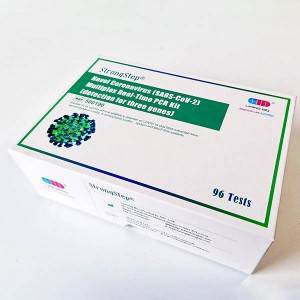


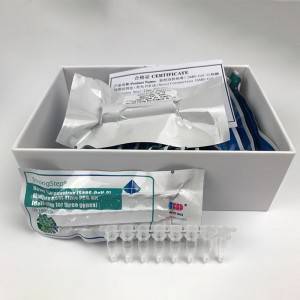


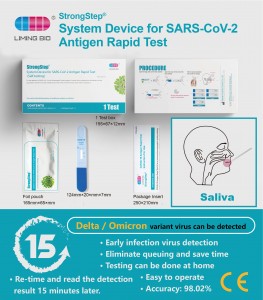
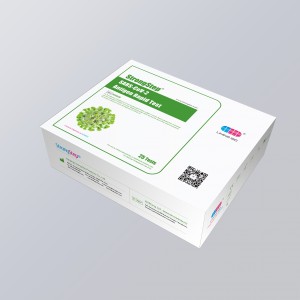
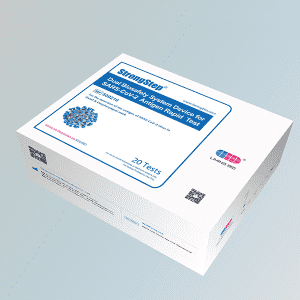
1人份抗原卡实物图唾液版1_00_副本-300x216.png)
